Nevertheless, Chinese coins dating back 2,000 years have been found in ancient Korean tombs proving that Korea was familiar with coinage long before the country began minting coins of its own.
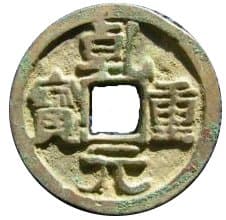
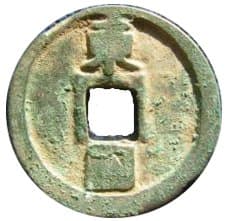 The first coins
actually minted in Korea occurred during the 15th year (996
AD) of the reign of King Songjong (成宗). This coin was
cast in both bronze and iron and was based on the standard
Chinese cash coin which was round with a square hole in the
center.
The first coins
actually minted in Korea occurred during the 15th year (996
AD) of the reign of King Songjong (成宗). This coin was
cast in both bronze and iron and was based on the standard
Chinese cash coin which was round with a square hole in the
center.A bronze example of the coin is shown at the left. It was unearthed in the city of Kaiyuan (开原) in China's northeast province of Liaoning (辽宁省). The bronze coins are much rarer than the iron ones and most of these coins have been found in China's northeast (Dongbei 东北) and in the northern part of the Korean peninsula.
The coin has the same Chinese character inscription, 乾元重寶 (kon won chung bo), as the coins cast during the reign (758-762) of Emperor Su Zong (肅宗) of the Tang Dynasty.
While the inscription on the Korean version of the coin is identical to that of the Chinese, two additional Chinese characters 東國 (tong guk), meaning "the country of the East", were added to the reverse side of the coin to indicate that the coin was from Korea which is a country east of China.
There is some controversy, however, concerning who actually produced the coin since no ancient Korean historical references mention it and the coin did not appear in any coin catalogues until 1938 when a Japanese coin catalogue (東亞錢志) attributed it as being Korean.
Some experts believe that these coins were actually cast by a Chinese state known as Bohai (渤海国) which existed in the area during the period 698-926. The Koreans consider the state to have been a Korean kingdom known as Balhae (발 해渤海). Unfortunately, no historical records exist from Bohai (Balhae) in regard to its coinage.
During the period 998-1009 AD, another coin was produced which was also based on a Chinese coin. This coin had the inscription 開元通寶 (kae won tong bo) which was the same as the coins cast during the reign of Emperor Gao Zu (高祖) of the Tang Dynasty.
However, use of these coins gradually declined and barter again became the predominant means of exchange.
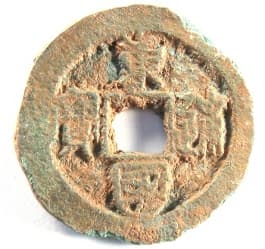 King
Sukjong
(肅宗) of Koryo tried again
to establish a monetary system by casting a variety of coins
during the years 1097-1107 AD. These coins included the
東國 (tong
guk "Eastern Country"),
海東 (hae dong "Eastern Sea")
and 三韓 (sam han "Three States") series of coins.
King
Sukjong
(肅宗) of Koryo tried again
to establish a monetary system by casting a variety of coins
during the years 1097-1107 AD. These coins included the
東國 (tong
guk "Eastern Country"),
海東 (hae dong "Eastern Sea")
and 三韓 (sam han "Three States") series of coins.In 1101 AD, King Sukjong had a very distinctive form of money produced. The money was in the form of a silver vase (unbyŏng 銀瓶) in the shape of the Korean peninsula. The vase had a wide mouth and contained one kun (斤), or about 600 grams, of silver.
The unbyŏng silver vases were very popular with the aristocracy for use in large-scale transactions and to pay bribes. Unfortunately, no specimens are now known to exist.
In the end, however, none of King Sukjong's attempts to establish a monetary system proved to be successful and the country again returned to using barter with rice and cloth as the medium of exchange.
Other attempts were made to create a monetary system during the next two centuries. In 1331, during the reign of Ch'unghyewang (忠惠王), bottle-shaped pieces of silver alloyed with copper and weighing about 454 grams were introduced as a form of money. Each of these bottle-shaped "coins" was worth the equivalent of one hundred pieces of linen.
During the reign (1352-1374) of Kongminwang (恭愍王), a standardized silver coin was issued but, regrettably, no specimens have survived and their actual appearance remains unknown.
Korea issued its first paper money in the year 1401 during the reign of T'aejong (太宗). This paper currency imitated an old Chinese note that was first issued in 1287.
Bronze coins were not cast again until the year 1423 AD during the reign of King Sejong (世宗) of the Yi Dynasty (1392-1910 AD). These coins had the inscription 朝鮮通寶 (chosun tong bo "Chosun Currency"). Chosun means "morning fresh" or "new morning" and is an ancient name for the country of Korea.
The chosun tong bo coins were standardized at 150 coins to one kun (斤 600 grams) of silver.
However, this coinage ceased after a few years because of the lack of raw materials and due to the exchange rate having fallen to less than the intrinsic value of the coin.
 In 1464, King
Sejo (Sei Jo 世祖) introduced a most
unusual and versatile form of money. The "arrow coin" (chŏn
p'ye, jun pei 箭幣) was in the
shape of an arrowhead which allowed it to be used as money
during times of peace and as an arrowhead during times of
war. The arrowhead was 55 mm long with the stem adding
an additional 52 mm to the length.
In 1464, King
Sejo (Sei Jo 世祖) introduced a most
unusual and versatile form of money. The "arrow coin" (chŏn
p'ye, jun pei 箭幣) was in the
shape of an arrowhead which allowed it to be used as money
during times of peace and as an arrowhead during times of
war. The arrowhead was 55 mm long with the stem adding
an additional 52 mm to the length.According to the Moon Heun Pi Ko (文猷備考), the royal instructions regarding the "arrow coin" can be translated as follows: "Different moneys were used in different reigns but each one suits its time. The arrow coin, though never used by the ancients, will surely prove useful to a warlike country and we see no reason why it should not be used."
The blade of the "arrow coin" resembled a willow leaf and on the stem was inscribed "eight directions universal money" ("currency in eight directions" p'albang t'onghwa 八方通寶) indicating that the coin was good everywhere.
One "arrow coin" was worth the equivalent of four pieces of paper money.
Unfortunately, this novel form of money was not well received by the people and, again, a money-based economy failed to be established. No specimen of this "arrow coin" is known to exist.
Coins were again cast during the 3rd year (1625 AD) of the reign of King Ingo (仁祖) of the Yi Dynasty (李 紀) . These coins had the same inscription 朝 鮮通寶 (chosun tong bo "Chosun Currency") as those of King Sejong (世宗). This time, however, laws were promulgated to enforce the usage of the coins. Stores were established to sell wine and food for money, and people gradually began to realize the advantages of a money system.
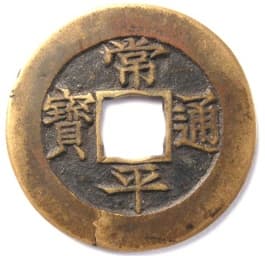 However, it was not
until the year 1633 during the reign of King Ingo (仁
祖) that the coin that has became
most representative of the coinage of Korea was first
cast. This is a round coin with a square hole in the
center, made of copper or bronze, that has the inscription sang
pyong tong bo (sang p'yŏng t'ong
bo
常平通寶, 상평통보;
Chinese
pinyin: chang ping tong bao).
The reverse sides of these coins can display a number, an
astronomical symbol like a star, moon or sun, a
character from the ancient Chinese text "The Thousand
Character Classic", a character of "The Five
Elements", etc.
However, it was not
until the year 1633 during the reign of King Ingo (仁
祖) that the coin that has became
most representative of the coinage of Korea was first
cast. This is a round coin with a square hole in the
center, made of copper or bronze, that has the inscription sang
pyong tong bo (sang p'yŏng t'ong
bo
常平通寶, 상평통보;
Chinese
pinyin: chang ping tong bao).
The reverse sides of these coins can display a number, an
astronomical symbol like a star, moon or sun, a
character from the ancient Chinese text "The Thousand
Character Classic", a character of "The Five
Elements", etc.An example of a sang pyong tong bo (sangpyungtongbo 常平通寶) coin is shown at the left.
There are estimated to be more than 5,000 varieties of this coin and the sang pyong tong bo coins were used for more than 250 years (1633-1891 AD) which was longer than any other coin in Korean history.
When Korean ports finally opened to foreign businessmen, it became apparent that these small denomination bronze coins were not convenient for doing business. Therefore, beginning in 1882, Korea started to mint silver coins with the inscription 大東 (daedong).
However, many of these coins ended up being taken out of the country to be melted and recast as "horse hoof silver" (馬蹄銀) ingots. As a result, the minting of these coins ceased in 1893.
During the time Korea endured being colonized by Japan starting in 1910, Japanese coinage was used instead of Korean coinage.
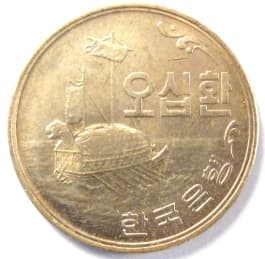
Modern Korean coinage began in 1959 (Korean calendar year 4292) with coins denominated in won (원).
The mugunghwa (Rose of Sharon 무궁화) flower, which is the national flower of Korea, was displayed on the 10 won coin.
The famous "Turtle Ship" (kobukson 거북선 龜船) of Admiral Yi Sunsin (李舜臣), as seen at the left, was on the 50 won coin and a portrait of Korea's first president, Syngman Rhee (이승만 李承晩), was on the 100 won coin.
Coins of
King Sukjong of the Koryo Dynasty
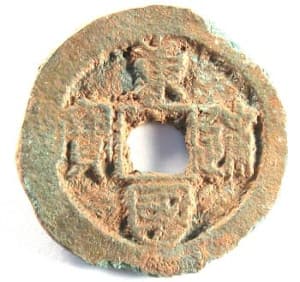 This
coin was cast during the years 998-1097 AD of the reign of
King Sukjong.
This
coin was cast during the years 998-1097 AD of the reign of
King Sukjong.The inscription is tong guk tong bo (dongkuktongbo 東國通寶) and the characters are read in the following order: top, bottom, right, left.
The inscription translates as "Eastern country currency".
The inscription is written in seal script (篆書) but other specimens exist in clerical script (隸書), regular script (楷書), and running script (行書).
Most specimens of this coin have the characters written in this order. However, there also exists a rare variety of this coin written in regular script (楷 書) in which the inscription is read clockwise beginning with the top character.
Similar to the Northern Song Dynasty coins which they imitate, these coins also have blank reverse sides with no characters or other symbols.
There are a number of varieties of this coin. Diameters range from 23 ~ 25 mm with weights from 2.4 ~ 3 grams.
The example shown above is known as the "long cap" variety because the top horizontal stroke of the bo (寶) character, located to the left of the square hole, extends downwards toward the bottom of the character on both sides.
In addition to this small cash coin, there were also larger "Value Two" coins cast with a diameter of about 30 mm and a weight of about 5.8 grams. These Value 2 coins are well-made and are extremely rare. Most have been excavated in the area of Kaesong (開城), the present capital of North Korea, which was the ancient capital city of Korea.
This particular coin has a diameter of 23 mm and a weight of 2.6 grams.
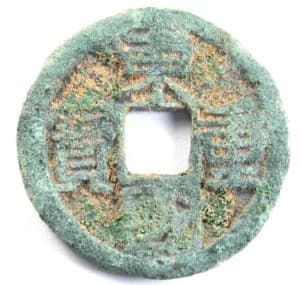 This
coin was also cast during the years 998-1097 of the reign
of King Sukjong (肅宗) of the Koryo Dynasty (高麗).
This
coin was also cast during the years 998-1097 of the reign
of King Sukjong (肅宗) of the Koryo Dynasty (高麗).The inscription is 東 國重寶 (tong guk chung bo, tong guk jung bo, dongkukjungbo) and the characters are read in the following order: top, bottom, right, left.
Specimens of this coin also exist with the inscription read in a clockwise manner but they are considered scarce.
The inscription translates as "Eastern country heavy currency".
All tong guk chung bo coins are written in a simple regular script (楷書).
These coins tend to be thicker and heavier than the tong guk tong bo (東 國通寶) coin shown above.
There are several varieties of this coin with the differences being in the way the characters are written and how broad or narrow is the outside rim.
Most of these coins are about 25 mm in diameter and weigh 2.8 ~ 3.6 grams.
This particular coin has a diameter of 24 mm but weighs a hefty 4.2 grams.
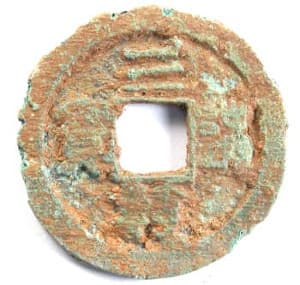 The 三
韓通寶 (sam han
tong bo) coins were cast
during the years 1097-1105 AD of the reign of King Sukjong
of the Koryo Dynasty (高麗).
These coins are similar to the hae dong and tong guk coins in that they imitate the
coins cast during the Song Dynasty of China.
The 三
韓通寶 (sam han
tong bo) coins were cast
during the years 1097-1105 AD of the reign of King Sukjong
of the Koryo Dynasty (高麗).
These coins are similar to the hae dong and tong guk coins in that they imitate the
coins cast during the Song Dynasty of China.Coins with this inscription exist written in seal script (篆 書), clerical script (隸書) and running script (行書).
There is a very rare version of the coin with the "three" (三) written in "official script" as 叁. Only one or two specimens of this coin are known to exist.
All of these coins have blank reverses.
The sam han tong bo coins tend not to be well-made. The rims are not uniform and the characters are not distinct.
The coins are fairly scarce.
Most of the coins have diameters of 23-25 mm and a weight of 2.6-3.4 grams.
This particular coin has a diameter of 25 mm and a weight of 2.1 grams.
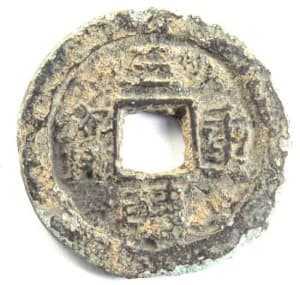 The 三
韓重寶 (sam han chung bo, sam han jung
bo) coin
was cast during the years 1097-1105 AD.
The 三
韓重寶 (sam han chung bo, sam han jung
bo) coin
was cast during the years 1097-1105 AD.The inscription translates as "Three Han heavy currency".
"Three Han" was another name for ancient Korea which consisted of three states with names ending in "Han". These were Ma Han (馬韓), Jin Han (辰韓) and Biun Han (辨韓).
This coin was made during the same time period as the 三韓通寶 (sam han tong bo) discussed above but, in general, appears to be slightly more refined.
Some sam han chung bo coins, such as the example at the left, have inscriptions written in the following order: top, bottom, right, left.
Other specimens have inscriptions written to be read in a clockwise manner starting with the character at the top.
All sam han chung bo coins have blank reverses.
Based on differences in the size of the characters and how broad or narrow the rim is, there are a number of varieties of this coin.
Most of these coins are approximately 25 mm in diameter.
This particular specimen has a diameter of 25 mm and a weight of 4 grams.
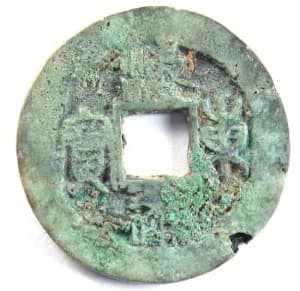 The inscription on
this coin is read clockwise, beginning with the character
at the top, as 海東通寶 (hae dong tong bo).
The inscription on
this coin is read clockwise, beginning with the character
at the top, as 海東通寶 (hae dong tong bo).The inscription translates as "Eastern Sea currency".
The "Eastern Sea" refers to Korea which is located east of the Yellow Sea.
These coins began to be cast in the 7th year (1097 AD) of the reign of King Sukjong (肅宗) and continued to 1105 AD.
Coins with this inscription were also cast with the characters read in the following order: top, bottom, right, left.
This coin is written in seal script (篆書) but other specimens exist in clerical script (隸書), regular script (楷書), and running script (行書).
This coin has a diameter of 25 mm and a weight of 2.9 grams.
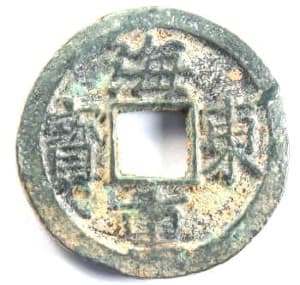 The
inscription on this coin is read clockwise as 海
東重寶 (hae dong
chung bo, hae
dong jung bo)
which translates as
"Eastern Sea heavy currency".
The
inscription on this coin is read clockwise as 海
東重寶 (hae dong
chung bo, hae
dong jung bo)
which translates as
"Eastern Sea heavy currency".These coins began to be cast in the 7th year (1097) of the reign of King Sukjong (肅宗) and continued to 1105 AD.
Only coins written in regular script (楷書) are known to exist.
Certain characteristics of these coins may indicate that they were cast before the 海東通寶 (hae dong t'ong bo) coins. For example, these coins tend to be thicker and the Chinese characters tend to be plainer. They more closely resemble the Korean version of the 乾 元重寶 (qian yuan zhong bao) coins.
Most of these coins are about 25 mm in diameter and weigh about 4 grams.
This example has a diameter of 25 mm and a weight of 3.1 grams.
There also exist versions of this coin with the inscription 海 東元寶 (hae dong won bo) written in regular script (楷 書) which closely resemble the Chinese Song Dynasty coins. The Chinese characters are very large. The coins are about 24 mm in diameter but relatively heavy at about 5.1 grams. On the reverse sides, below the square hole, there appears to be what looks like a Chinese character. If it is a character, however, it has not yet been identified.
The 海東元寶 coins are very rare and most old Korean reference books do not even include them.
The only recent specimens have been excavated in the area near Kaesong (開城), the present capital of North Korea.
In 1392 AD, General Yi Songgye (李成桂) of the Yi Dynasty (Choson or Chosun or Joseon Dynasty 1392-1910 AD) proclaimed himself to be King Taejo (太祖) and changed the name of the country to Choson (朝鮮).
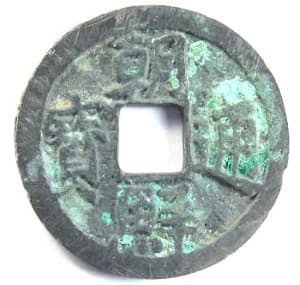 Choson tong bo (朝
鮮通寶) coins were actually cast during two time
periods. The first period was during the 5th -
7th years (1423-1425 AD) of the reign of King Sejong
(世宗) when the
coins were cast written in "orthodox" script
(楷書).
Choson tong bo (朝
鮮通寶) coins were actually cast during two time
periods. The first period was during the 5th -
7th years (1423-1425 AD) of the reign of King Sejong
(世宗) when the
coins were cast written in "orthodox" script
(楷書).The coin at the left is an example of a choson tong bo (朝 鮮通寶). The characters are read in the following order: top, bottom, right, left.
The inscription translates as "Choson currency".
The characters on these coins tend to be clear and distinct. The reverse sides are blank.
The coins are about 24 mm in diameter and weigh 3.2 - 4 grams.
There are many varieties of this coin.
This specimen has a diameter of 24.5 mm and a weight of 2.4 grams.
The second time coins with the inscription Choson tong bo (朝 鮮通寶) were cast was 200 years later in the 3rd year (1625 AD) of the reign of King Injo (仁 祖) of the Yi Dynasty (Choson or Chosun or Joseon Dynasty 李紀).
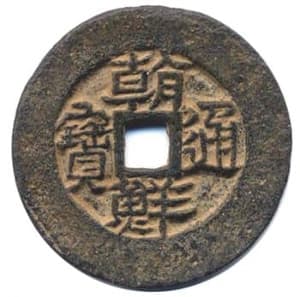 Unlike the earlier Choson
tong bo (朝鮮通寶) coins, these coins had the
inscription written in "official style" (palbun 八分)
as in the
example
at the left.
Unlike the earlier Choson
tong bo (朝鮮通寶) coins, these coins had the
inscription written in "official style" (palbun 八分)
as in the
example
at the left.The coins tend to have a yellow-brown color and the characters are not very standardized. The strokes can be thin or thick and small or large. Some varieties have broad rims while others have narrow rims.
Both government and private versions were cast and, therefore, coins can vary from well-made to crude.
Unlike the earlier version of the coin, coins with inscriptions written in clerical script (隸書) are much scarcer.
Finally, there exists a "Value Ten" version of the coin. These coins have a diameter of 45 mm and a weight of about 30 grams.
These "Value Ten" coins are very rare.
Chosŏn T'ong Bo "Value Ten" and "One Chŏn" Test Coins
Test coins with the inscription chosŏn t'ong bo (朝鮮通寶) in denominations of "Value Ten" (sip 十) and "One Chŏn" (il chŏn 一錢) were cast in or about the year 1881.These coins are very rare and were not released for circulation.
Unfortunately, there exists very little reliable information regarding the coins.
According to this Chinese article, the Value Ten test coins can have either a plain reverse (光背) or have the character 十 (sip), meaning "ten", above the square hole on the reverse side.
Also, the plain reverse coins can be found in two varieties depending on whether the characters on the obverse side are "small" (小字) or "large" (大字).
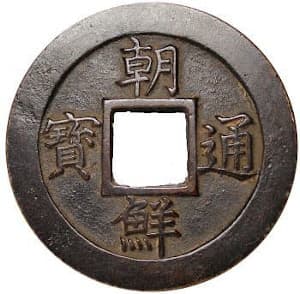
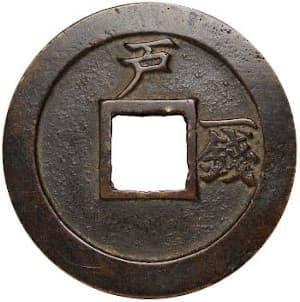 There is also
a chosŏn t'ong bo denomination
"One Chŏn" (il
chon 一錢) test coin,
displayed at the left, which on the reverse side has the
character 户 (ho)
above and the characters 一錢 (il
chŏn)
to the right of the square hole.
There is also
a chosŏn t'ong bo denomination
"One Chŏn" (il
chon 一錢) test coin,
displayed at the left, which on the reverse side has the
character 户 (ho)
above and the characters 一錢 (il
chŏn)
to the right of the square hole.Ho (户) is the mint mark of the Treasury Department (Hojo 户曹) and il chŏn (一 錢) represents the denomination "one chŏn".
At the time, 400 small cash coins were the equivalent in value to one tael (一两) of silver. One of these il chŏn (一 錢) test coins would have been worth the equivalent of 40 of the Value 10 test coins.
Some varieties of this coin have a line (一) above the 户, as in this specimen. Other coins lack this top bar.
There can also be slight differences in the way the "head" or upper part of the t'ong (通) is written.
Regarding the sŏn (鮮) character, there are slight differences in the way the four "dots" at the bottom of the 魚 are written as well as the way the "head" of the 羊 is written.
No diameter or weight is given in the article for the chosŏn t'ong bo "One Chŏn" coin displayed above.
The other Chinese article, however, does provide information on the specimens it discusses. The plain reverse "Value Ten" test coin has a diameter of 48.2 mm and a weight of 29 grams. The "One Chŏn" test coin has a diameter of 47.6 mm and a weight of 31 grams.
As already mentioned, these test coins are very rare and not well documented. As a result, there is some dispute among Korean coin experts as to which specimens are authentic and which are later reproductions.
"Sang Pyong Tong Bo" (常平通寶) Coins
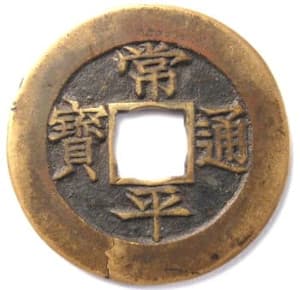
Beginning in the year 1633 AD during the reign of King Injo (仁 祖) of the Yi Dynasty (Choson, Chosun, Joseon Dynasty 李紀), the "Stabilization Office" (Sangpyongchong 常平廳), which was a famine relief office, began to cast coins utilizing the first two characters of the office name 常 平 (sang pyong, sang p'yŏng) in the coin inscription 常 平通寶 (sang pyong tong bo, sang p'yŏng t'ong bo, sangpyungtongbo 상 평통보; Chinese pinyin: chang ping tong bao).
The inscription can be translated as "always even currency".
The reverse side of these first coins was blank.
The coin at the left is an example of a sang pyong tong bo (常 平通寶) coin.
In 1651, King Hyojong (孝宗) issued a decree ordering the people to use the coin and prohibiting them from using cloth as money.
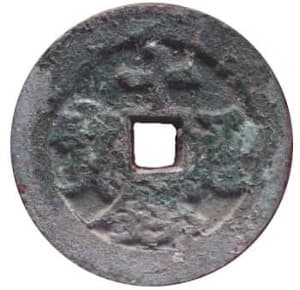
Also, private mintage was permitted at this time.
The inscription on the coin at the left is sip jun tong bo (sip chŏn t'ong bo 十钱通宝; Chinese shi qian tong bao) which translates as "ten cash currency".
There is some controversy as to when these "Value Ten" cash coins were actually cast. Some experts believe that they were privately cast around 1651 during the reign of King Hyojong.
Others believe that these coins were cast beginning in the year 1793 during the reign of King Chŏngjo (Jeongjo 正祖).
These "ten cash currency" coins exist in sizes ranging from 28 mm to 40 mm and in different calligraphic styles which seems to support the belief that they were privately cast.
The use of coins and the implementation of an economy based on money, instead of cloth or rice, was further strengthened when King Sukjong (肅宗) in 1678 ordered that additional mints be established to produce the sang pyong tong bo coins.
Sang pyong tong bo coins were cast from 1633 to 1891 and continued to circulate for over 300 years. In addition to the large number of government and military mints that made these coins, many sang pyong tong bo coins were also privately cast.
As mentioned above, there are estimated to be more than 5,000 varieties of sang pyong tong bo coins with many varieties still undocumented. The authoritative Korean coin catalog 高丽朝鲜时代货币 documents 3,078 varieties of the One Mun, Two Mun and Five Mun coins, and 48 varieties of the One Hundred Mun coin.
Denominations of Sang Pyong Tong Bo Coins
The mun was the Korean equivalent of the wen (文) or "cash" coin ("leaf money", "leaf coin" yŏpchŏn, yupjun 葉錢) of China and the mon (文) of Japan.
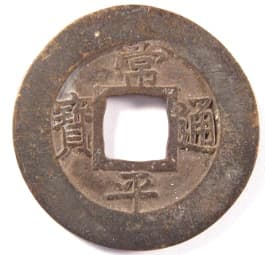
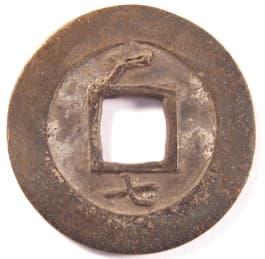
This is an example of a One Mun ("Value One" dangiljun 當一錢) sang pyong tong bo coin.
The image at the far left is the obverse side with the inscription read (top, bottom, right, left) as sang pyong tong bo (常 平通寶).
The one mun coins have a diameter of 24-25 mm.
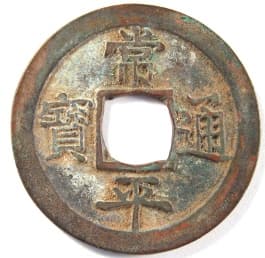
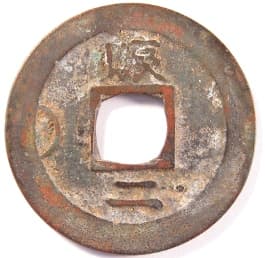
This is a Two Mun ("Value Two" dangijun 當二錢) sang pyong tong bo coin.
Two mun coins began being cast in 1679.
The two mun coins have a diameter of 27-29 mm.
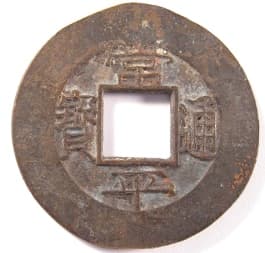
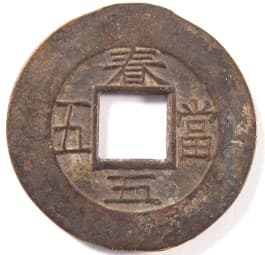
This is a Five Mun ("Value Five" tangojon or dangohjun 當五錢) sang pyong tong bo coin.
Casting of five mun coins began in 1883.
The five mun coins have a diameter of 31-33 mm.
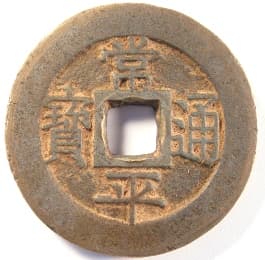
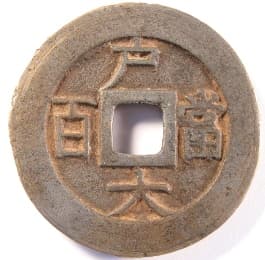
This is a One Hundred Mun ("Value Hundred" tangbaekchon or dangbaekjun 當 百錢) sang pyong tong bo coin.
The One Hundred Mun is the only denomination of sang pyong tong bo coinage for which accurate mint records exist. These coins were first cast by the Treasury Department on December 12, 1866 and put into circulation beginning January 15, 1867. The last coin was produced on June 16, 1867 which means these coins were cast for only 172 days. A total of 1,784,038 "One Hundred Mun" coins were cast by the government.
The One Hundred Mun coins minted by the government have a diameter of 40.6 mm, a thickness of 2.8 mm and a weight of 25.1 grams.
With so many mints producing the smaller denomination coins over such a long period of time, it is inevitable that the diameter and weight of the coins would vary.
In general, coins that are well-cast with clear inscriptions and a yellowish color were produced during an early period at a government mint.
Coins that are less refined were cast at a later period.
Most privately cast coins tend to have a crude appearance with indistinct characters and a blackish tint.
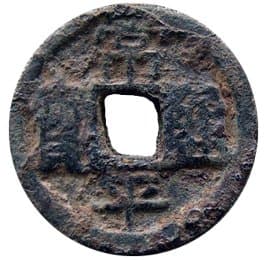 At the
left is a sang pyong
tong bo coin made of iron (铁).
At the
left is a sang pyong
tong bo coin made of iron (铁).I am not aware of any historical records indicating Korean coins of this period having been made of iron. However, this iron coin was, according to reports, recently found in a hoard of coins in Dongbei (东北 "Manchuria") which is the area of northeast China that borders on Korea.
The cache included coins from the Tang (618-907) to the Qing (1644-1911) dynasties. The earliest coins were kai yuan tong bao (开元通宝 621-907) and the latest were qian long tong bao (乾隆通宝 1736-1795). Coins from Korea, Annam (Vietnam) and Japan were also found in the hoard which is believed to have originally come from "traders".
The reverse side is blank with no indication of the mint or any other symbol. It is, therefore, unknown when or where the coin was made.
The owner states that the coin is modeled after the Northern Song Dynasty tai ping tong bao (太平通宝) coin with the tai (太) being changed to a sang ("chang" 常). He also thinks the coin may have been cast in the early years of the sang pyong tong bo series.
This coin was the only iron sang pyong tong bo coin in the hoard and may be unique.
The coin has a diameter of 24.13 mm and a weight of 4.2 grams.
I am grateful to lindascoin, the present owner, for providing the information on this rare coin.
Many sang pyong tong bo coins eventually made their way to China where they circulated together with Chinese cash coins.
Sang pyong tong bo coins were also popularly used to embellish old Korean charms.
Characteristics
of the Sang Pyong Tong Bo Inscription
All the characters on the reverse side are also written in "Regular Script" with the sole exception of the character 經 (kyong), indicating the "Government Office of Pukhan Mountain Fortress, which is written in "Running Script" (行 書).
Another characteristic of the inscription on sang pyong tong bo coins is that there is only the tong bo (通 寶) or "universal currency" version. "Original currency" (元寶) and "heavy currency" (重寶) are not used in the inscriptions to indicate larger denominations of the coins as is common with Chinese cash coins. Therefore, even the "One Hundred Mun" coin is a "通寶". If it had been cast in China at an earlier time, it could very well have been a 重寶 or "heavy currency".
The reason why only tong bo (通 寶) was used in the inscription, despite differences in denominations, has to do with the very close ties that existed between the Yi (Choson) Dynasty (1392-1897) and the Ming Dynasty (1368-1644) of China.
All the cash coins of the Ming Dynasty are also designated as 通寶 (tong bao).
The 元寶 (yuan bao) designation was not used on the coinage of the Ming Dynasty because it was prohibited to use the Emperor's name. The founder and first emperor of the Ming Dynasty was the Hongwu Emperor (洪武帝), also known as Emperor Tai Zu. Emperor Tai Zu's real name was Zhu Yuanzhang (朱元璋). You will note that there is a "元" character in his name. For this reason, it was prohibited to use the designation "元寶" on Ming Dynasty coins and the Koreans respected this prohibition on their own coinage.
Mints Casting Sang
Pyong Tong Bo Coins
In 1633, the "Stabilization Office" (Sangpyongchong 常平廳) became
the first mint to cast sang
pyong tong bo coins. Over the next 250
years, other government offices and military units also
established mints to cast these coins.The following chart identifies these major government and military mints as well as the year they first began to cast sang pyong tong bo coins.
| Mint
mark |
Agency |
English |
First Year Cast
|
| 户 |
户曹
Hojo |
Treasury Department |
1678 |
| 工 |
工曹 Kongjo |
Ministry of
Industry |
1685 |
| 均 |
均役廳 Kyunyokchong |
Government Tithe
Office |
1807 |
| 司 | 司仆寺 Kyong Saboksi |
Bureau of Royal
Transportation |
1678 |
| 賑 | 賑恤廳 Chinhyulchong |
Charity Office in
Seoul |
1742 |
| 向 |
粮餉廳 Yanghyang chong |
Food Supply Office |
1742 |
| 宣 | 宣惠廳 Sonhyechong |
Rice and Cloth
Department |
1742 |
| 惠 | 宣惠廳 Sonhyechong |
Rice and Cloth
Department |
1806 |
| 典 | 典圜局 Chonhwanguk |
Central Government
Mint |
1833 |
| 兵 | 兵曹 Pyongjo |
Ministry of Defense |
1742 |
| 備 | 備邊司 Pibyon sa |
National Defense
Bureau |
1742 |
| 捻 | 捻戎廳 Chongyung chong |
General Military
Office |
1692 |
| 营 or 營 | 御营廳 Oyongchong |
Special Army Unit |
1678 |
| 武 武 |
武備司 Mubisa 武衛營 Muwiyong |
Armaments Bureau Guard Office at the Palace |
1742 |
| 禁 | 禁衛營 Kumwiyong |
Court Guard
Military Unit |
1742 |
| 訓 | 訓練都監 Hullyondogam |
Military Training
Command |
1678 |
| 抄 | 精抄廳 Chongchochong |
Commando Military
Unit |
1678 |
| 統 統 |
統營 Tongyong 統衛營 Tongwiyong |
Tongyong Naval
Office Military Office in Seoul |
1727 |
| 經 | 經理廳 Kyongnichong |
Government Office
of Pukhan Mountain Fortress |
1830 |
| 守 | 守御廳 Suochong |
Seoul Defense Fort |
1742 |
| 沁 | 沁華管理營 Sim Kanghwa
Kwalliyong |
Kanghwa Township
Military Office |
1883 |
| 開 |
開城管理營 Kaesong Kwalliyong |
Kaesong Township
Military Office |
1678 |
| 松 |
開城管理營 Kaesong Kwalliyong |
(Song) Kaesong
Township Military Office |
1882 |
| 利 |
利原管理營 Iwon Kwalliyong |
Iwon Township
Military Office |
1882 |
| 水 |
水原管理營 Suwon Kalliyong | Suwon Township
Military Office |
1727 |
| 原 |
原州管理營 Wonju Kwalliyong | Wonju Township
Military Office |
1678 |
| 海 |
海州管理營 Haeju Kwalli yong | Haeju Township
Military Office |
1742 |
| 春 |
春川管理營 Ch'unch'on Kwalliyong | Ch'unch'on Township
Military Office |
1888 |
| 川 |
端川管理營 Tanch'on Kwalliyong | Tanch'on Township
Military Office |
1883 |
| 昌 |
昌德宮 Ch'angdok Kung 昌原管理營 Ch'angwon Kwalliyong |
Ch'angdok Palace
Mint Ch'angwon Township Military Office |
1864 |
| 圻 |
廣州管理營 Kwangju Kwalliyong | Kwangju Township
Military Office in Kyonggi Province |
1742 |
| 京 |
京畿監營 Kyonggi Kamyong | Kyonggi Provincial
Office |
1742 |
| 京
水 |
京畿水營 Kyonggi Suyong | Kyonggi Naval
Station |
1742 |
| 黃 |
黃海監營 Hwanghae Kamyong | Hwanghae Provincial
Office |
1742 |
| 平 |
平安監營 P'yongan Kamyong | P'yongan Provincial
Office |
1678 |
| 平
兵 |
平安兵營 P'yongan Pyongyong | P'yongan Military
Fort |
1678 |
| 咸 |
咸鏡監營 Hamgyong Kamyong | Hamgyong Provincial
Office |
1742 |
| 咸
北 |
咸鏡北營 Hamgyong Pugyong | North Hamgyong
Provincial Office |
1742 |
| 咸
南 |
咸鏡南營 Hamgyong Namyong | South Hamgyong
Provincial Office |
1742 |
| 江 |
江原監營 Kangwon Kamyong | Kangwon Provincial
Office |
1742 |
| 尚 |
慶尚監營 Kyongsang Kamyong | Kyongsang
Provincial Office |
1695 |
| 尚
水 |
慶尚水營 Kyongsang Suyong | Kyongsang Naval
Station |
1695 |
| 尚
右 |
慶尚右營 Kyongsang Uyong | Kyongsang Right
Naval Base |
1695 |
| 尚
左 |
慶尚左營 Kyongsang Chwayong | Kyongsang Left
Naval Base |
1695 |
| 全 |
全羅監營 Cholla Kamyong | Cholla Provincial
Office |
1682 |
| 全
兵 |
全羅兵營 Cholla Pyongyong | Cholla Military
Fort |
1678 |
| 全
右 |
全羅右營 Cholla Uyong | Cholla Right Naval
Base |
1678 |
| 全
左 |
全羅左營 Cholla Chwayong | Cholla Left Naval
Base |
1678 |
| 忠 |
忠清監營 Ch'ungch'ong Kamyong | Ch'ungch'ong
Provincial Office |
1742 |
The "mint mark" (first column in above table) on the sang pyong tong bo coins can be found at the top (above the square hole) on the reverse side of the coin.
The table below shows examples of sang pyong tong bo coins from some of these mints.
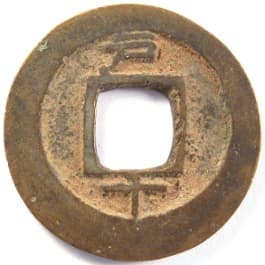
"ho"
Treasury Department
1731
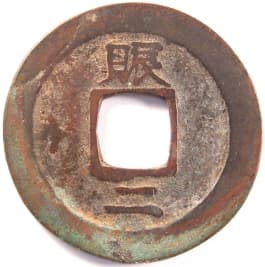
"chin"
Charity Office in Seoul
1695-1742
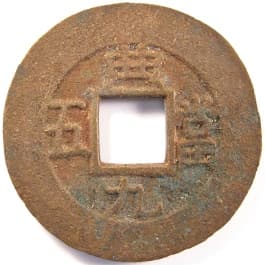
"chŏn"
Central Government Mint
1883
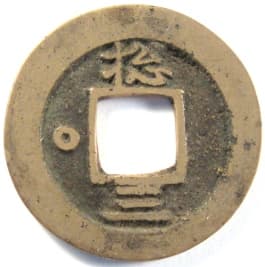
"ch'ong"
General Military Office
1757
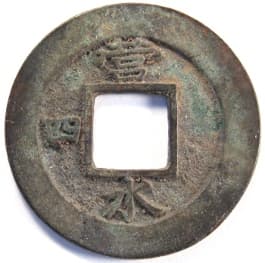
"yŏng"
Special Army Unit
1752
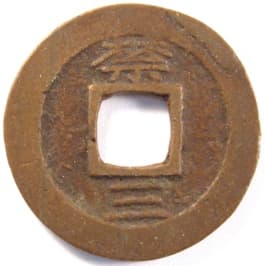
"kŭm"
Court Guard Military Unit
1823
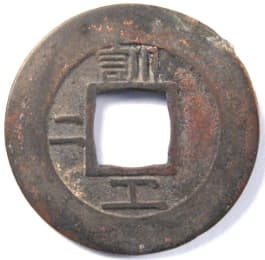
"hun"
Military Training Command
1857
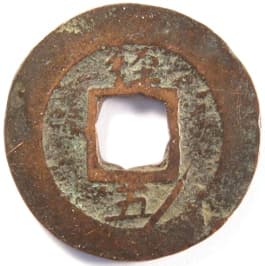
"kyŏng"
Government Office of Pukhan Mountain Fortress
1830
* (flower hole)
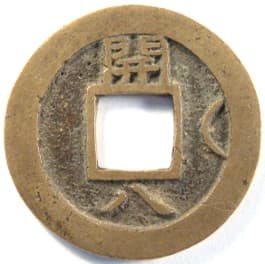
"kae"
Kaesong Township Military Office
1816
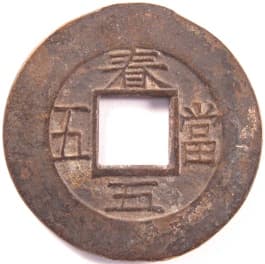
"ch'un"
Ch'unch'on Township Military Office
1888
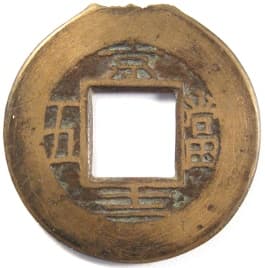
"kyŏng"
Kyonggi Provincial Office
1888
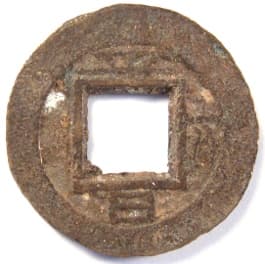
"p'yŏng"
P'yongan Provincial Office
1891
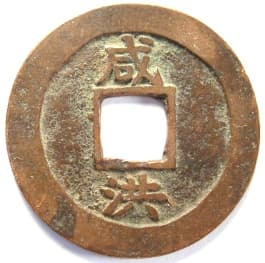
"ham"
Hamgyong Provincial Office
1742-1752
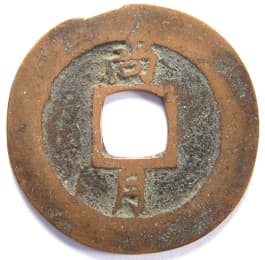
"sang"
Kyongsang Provincial Office
1742-1752
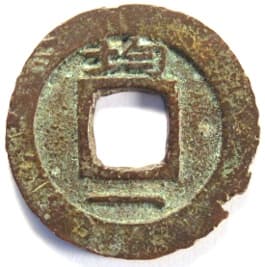
"kyun"
Government Tithe Office
1807
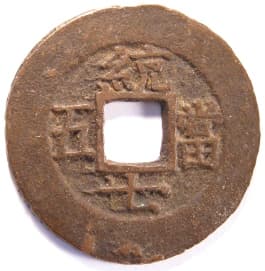
"t'ong"
Military Office in Seoul
1883
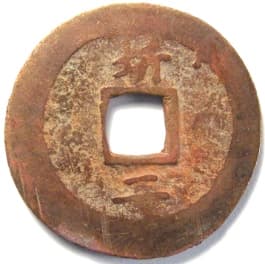
"ki"
Kwangju Township Military Office in Kyonggi Province
1742-1752
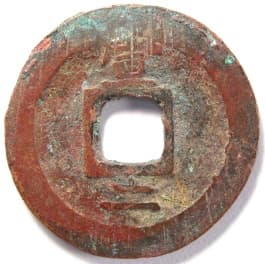
"sŏn"
Rice & Cloth Department
1742-1752
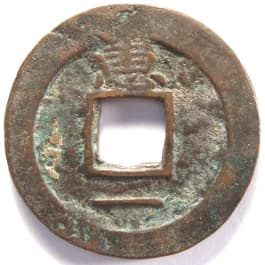
"hye"
Rice & Cloth Department
1806
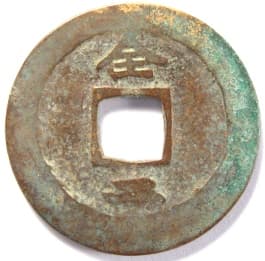
"chŏn"
Cholla Provincial Office
1679-1695
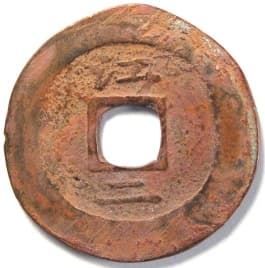
"kang"
Kangwon Provincial Office
1742-1752
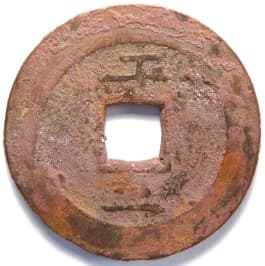
"kong"
Ministry of Industry
1685-1752
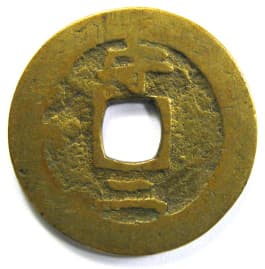
"su"
Seoul Defense Fort
1742-1752
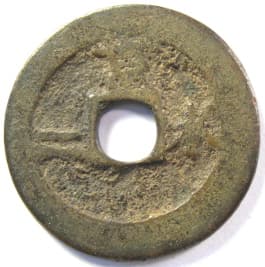
"kyŏng su"
Kyŏnggi Naval Station
1742-1752
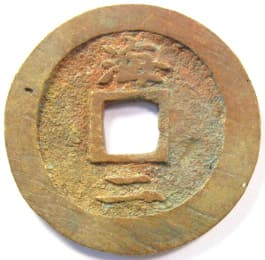
"hae"
Haeju Township Military Office
1742-1752
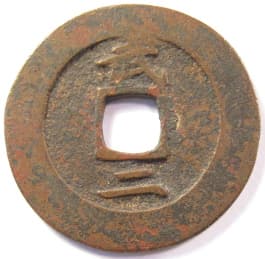
"mu"
Armaments Bureau
1742-1752
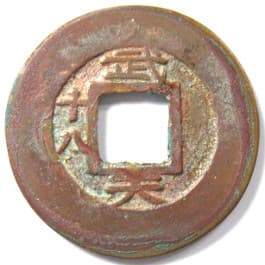
"mu"
Guard Office at the Palace
1881
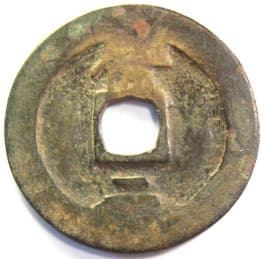
"pi"
National Defense Bureau
1742
* If you look carefully, you will notice that this coin
cast at the "Government Office of Pukhan Mountain
Fortress" has an eight-sided "flower hole" ("rosette
hole"). In China, coins with flower holes were
very scarce until the Song Dynasty (960-1279).
Coins exhibiting flower holes gradually decreased during
the following dynasties. The last Chinese coins
with flower holes were probably cast at the end of the
Ming Dynasty (1368-1644 AD). This particular
Korean coin is most unusual because very few non-Chinese
coins with flower holes have been found. For additional
information on "flower hole" coins please see "Chinese Coins with Flower
(Rosette) Holes".
Symbols, Numbers and Special Characters
These markings began to appear in the year 1742 and are believed to indicate "furnace" or "series" numbers.
Many of the coins simply show a Chinese number.
But the sang pyong tong bo coins are unique in that they also use several other methods to express "numbers".
For example, some coins have dots, circles, crescents, horizontal lines, and vertical lines. "Dots" represent "stars". "Circles" represent the "sun". "Crescents" represent the "moon". The "horizontal lines" represent the "earth" and the "vertical lines" represent "man".
These are very old symbols that first appeared on ancient Chinese coins.
Examples of sang pyong tong bo coins with Chinese numbers as well as dots, circles, crescents and lines may be seen below.
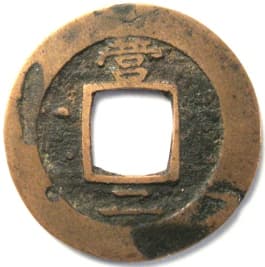
Number "2" (二)

Number "3" (三)

Number "8" (八)
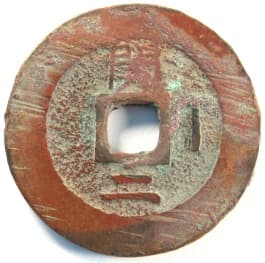
Number "2" (二)
These special symbols are discussed in the sections below.
The Thousand Character Classic
Up until the early 20th Century, Korea instead relied on the use of Chinese characters for its written language which is why all the inscriptions on old Korean coins are written with Chinese characters.
For many centuries one of the principal books for learning Chinese in both China and Korea was the 千字文 or "Thousand Character Classic" (Chinese: qian zi wen Korean: cheonjamun, ch'ŏn ja mun). The "Thousand Character Classic" was written in China by Zhou Xingxi (周兴嗣) at the request of Emperor Wu (武梁帝) who reigned during the years 502-549 AD of the Liang Dynasty.
The primer is actually a poem structured as 250 phrases with each phrase composed of only 4 Chinese characters. The entire poem is thus 1000 characters and no character is used more than once.
Since it was written as a poem, it could be fairly easily memorized and therefore served as an excellent tool to teach Chinese.
As an example, the following are the first 44 characters of the Thousand Character Classic:
日月盈昃 辰宿列張
寒来暑往 秋收冬藏
閏餘成歲 律吕調陽
雲騰致雨 露結為霜
金生麗水
"Heaven is dark, the earth is yellow; the universe is vast and barren
The setting sun, the full moon, and the stars, arranged in order
Cold comes and heat departs; autumn harvests provide winter hoards
The intercalary surplus completes the year; music harmonizes the two principles of nature
Clouds ascend and bring rain; dew congeals and forms frost
Gold is found in the Li River; ..."
Since no character is repeated, the "Thousand Character Classic" was frequently used as a numbering system for the numbers 1 to 1,000.
Starting in the year 1742, some sang pyong tong bo coins began to display furnace or series numbers on their reverse sides. Chinese numbers were commonly used but other symbols were sometimes used as well.
For example, the first 44 characters of the Thousand Character Classic displayed above were used on some sang pyong tong bo coins for this purpose.
These characters are usually placed at the bottom (below the square hole) on the reverse side of the coins.
Examples of sang pyong tong bo coins with characters from the "Thousand Character Classic" are shown below.
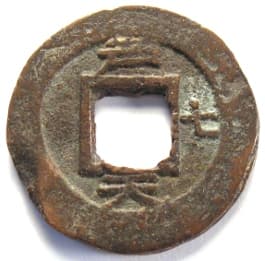
"chon"
"Heaven"
1832
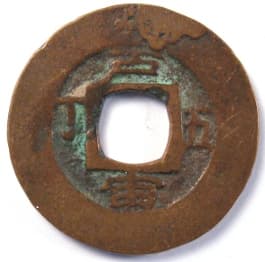
"chu"
"Time"
1832
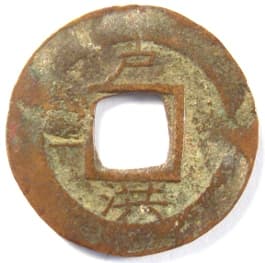
"hong"
"Flood"
1852

"il"
"Sun"
1891

"wol"
"Moon"
1742-1752
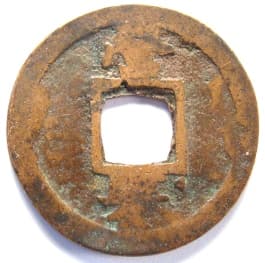
"han"
"Cold"
1742-1752
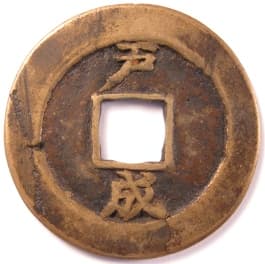
"song"
"Completes"
1742-1752
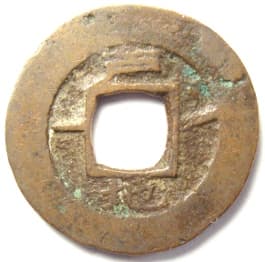
"chi"
"Earth"
1852
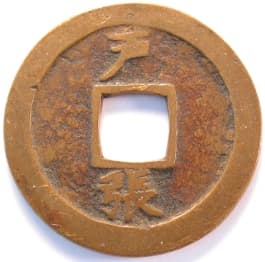
"chang"
"Extend"
1742-1752
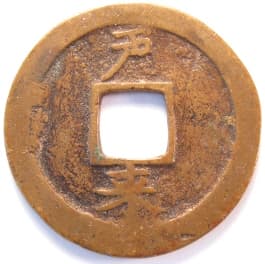
"nae"
"Comes"
1742-1752
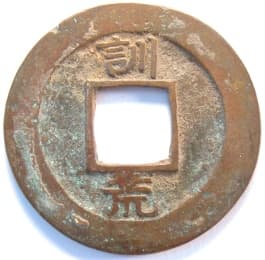
"hwang"
"Barren"
1753
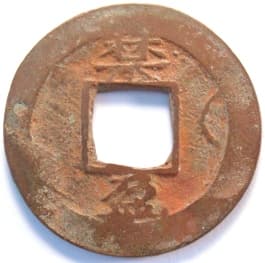
"yŏng"
"Full"
1753
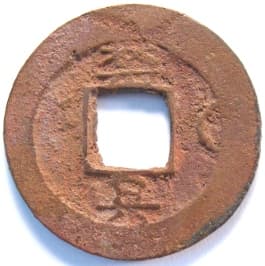
"ch'ŭk"
"The Declining Afternoon Sun"
1753
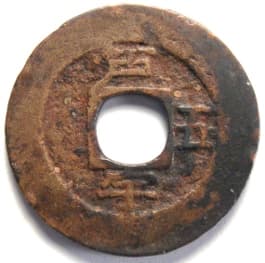
"u"
"Space"
1832
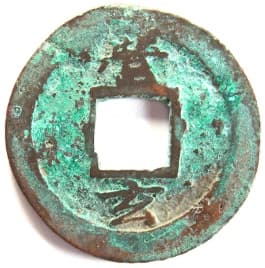
"hyŏn"
"Dark"
1742-1752
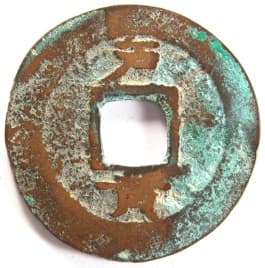
"hwang"
"Yellow"
1742-1752
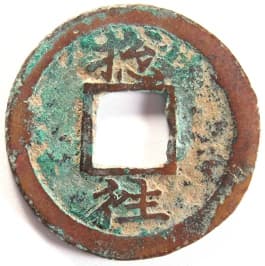
"wang"
"Depart"
1742-1752
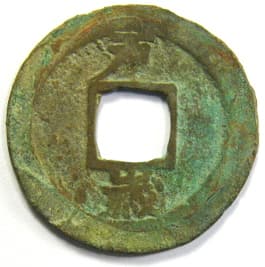
"se"
"Year"
1742-1752
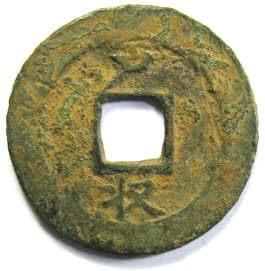
"su"
"Harvest"
1742-1752
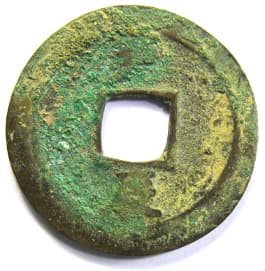
"chin"
"Heavenly Body"
1742-1752

"yŏl"
"Arranged in Order"
1742-1752
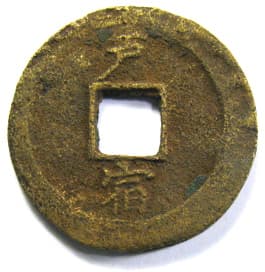
"suk"
"Lunar Station"
1742-1752
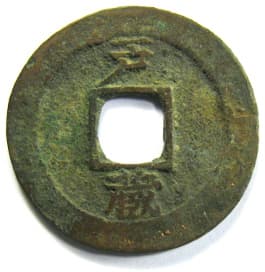
"chang"
"Hoard"
1742-1752
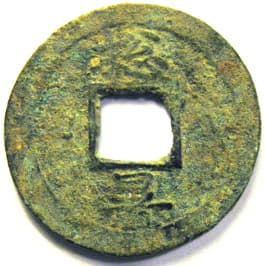
"sŏ"
"Heat"
1742-1752
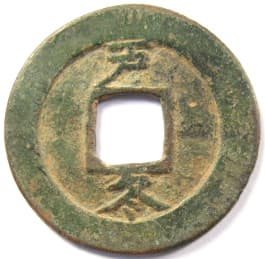
"tong"
"Winter"
1742-1752
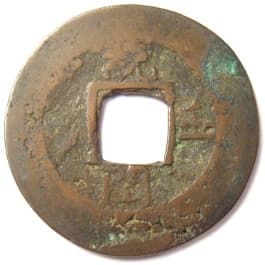
閏
"yun"
"Intercalary"
1752
The Five Elements
The "Five Elements" refer to the ancient Chinese belief that the entire universe is composed of these five basic essences or "elements": metal (kum 金), wood (mok 木), water (su 水), fire (hwa 火) and earth (to 土).
A complete set of sang pyong tong bo coins displaying the "Five Elements" cast at the Special Army Unit mint may be seen below.
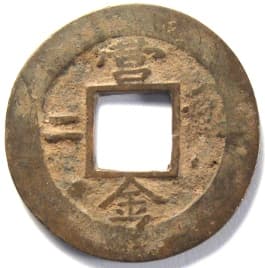
"kum"
"Metal"
1752

"su"
"Water"
1752
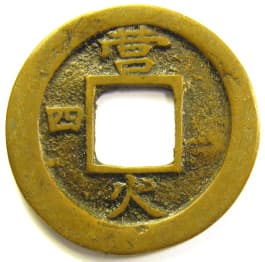
"hwa"
"Fire"
1752
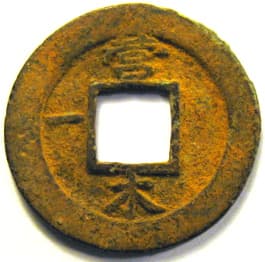
"mok"
"Wood"
1752
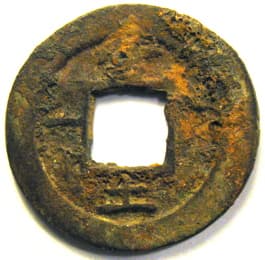
"t'o"
"Earth"
1752
The Ten Celestial Stems
The traditional Chinese calendar is based on pairing one of the "Ten Celestial Stems" with one of the "Twelve Terrestial Branches". These pairings result in 60 combinations which form the sixty-year cycle of the calendar. When one cycle is completed, another begins.
| Celestial Stem | Korean |
Chinese |
| 甲 |
gap | jia |
| 乙 |
eul |
yi |
| 丙 |
byeong |
bing |
| 丁 |
jeong |
ding |
| 戊 |
mu |
wu |
| 己 |
gi |
ji |
| 庚 |
gyeong |
geng |
| 辛 |
sin |
sin |
| 壬 |
im |
ren |
| 癸 |
gye |
gui |

"jeong"
1832

"im"
1752
The Twelve Terrestrial Branches
Some sang pyong tong bo coins have one of the "Twelve Terrestrial Branches" on the reverse side to indicate a series or furnace number.
The "Twelve Terrestrial Branches", also known as the "Twelve Earthly Branches", are identified in the following table.
| Terrestrial
Branch |
Korean |
Chinese |
| 子 |
cha |
zi |
| 丑 |
ch'uk |
chou |
| 寅 |
in |
yin |
| 卯 |
myo |
mao |
| 辰 |
ch'en |
chen |
| 巳 |
sa |
si |
| 午 |
o |
wu |
| 未 |
mi |
wei |
| 申 |
sin |
shen |
| 酉 |
yu |
you |
| 戌 |
sul |
xu |
| 亥 |
hae |
hai |
The Eight Trigrams
A solid line represents the yang (阳), or "male", while a broken line represents the um (阴), or "female".
Yin Yang (阴 阳 Korean: um yang) is the Chinese term for the basic polarities of the universe, e.g. male/female, light/dark, strong/weak, etc.
There are eight possible combinations of trigram components and these combinations are known as the "eight trigrams" (八 卦).
The "eight trigrams" have been used in divination since very ancient times.
A very few of the two mun ("Value Two" dangijun 當 二錢) sang pyong tong bo coins cast at the "T'ongyong Naval Office" (統 營) mint display symbols of the "eight trigrams" on the reverse side.
For a better understanding of the "Eight Trigrams", please see "Trigrams and Bagua".
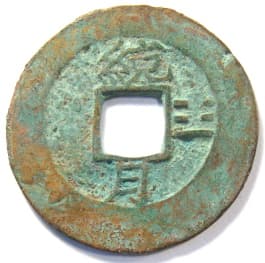
"wŏl"
"Moon"
T'ongyong Naval Office
1742-1752
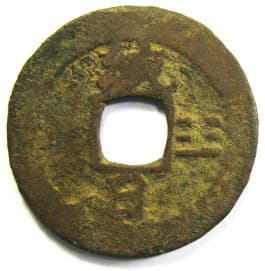
"il"
"Sun"
T'ongyong Naval Office
1742-1752
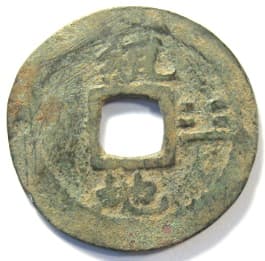
"chi"
"Earth"
T'ongyong Naval Office
1742-1752
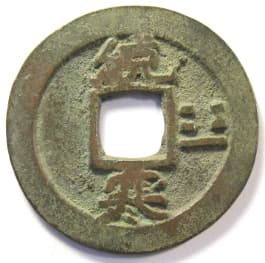
"han"
"Cold"
T'ongyong Naval Office
1742-1752
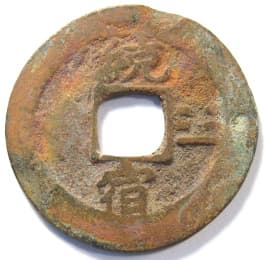
"suk"
"Lunar Station"
T'ongyong Naval Office
1742-1752
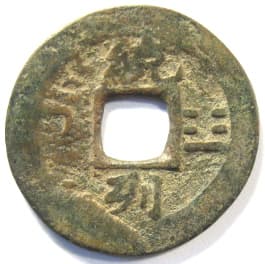
"yŏl"
"Arranged in Order"
T'ongyong Naval Office
1742-1752
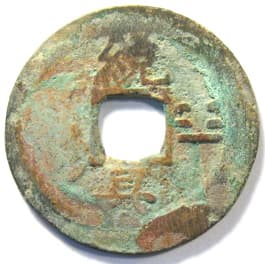
"ch'ŭk"
"The Declining Afternoon Sun"
T'ongyong Naval Office
1742-1752
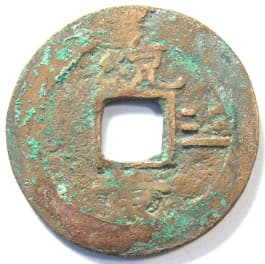
"hwang"
"Yellow"
T'ongyong Naval Office
1742-1752
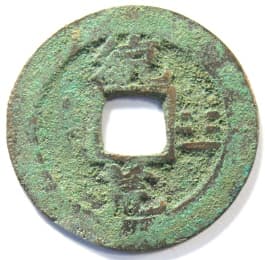
"hwang"
"Barren"
T'ongyong Naval Office
1742-1752
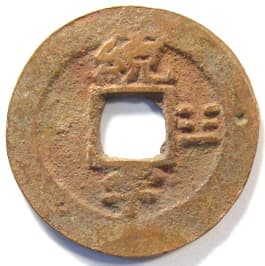
"u"
"Space"
T'ongyong Naval Office
1742-1752
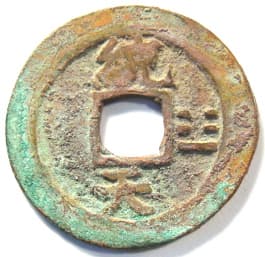
"ch'ŏn"
"Heaven"
T'ongyong Naval Office
1742-1752
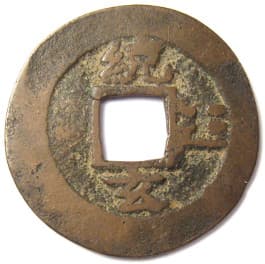
"hyŏn"
"Dark"
T'ongyong Naval Office
1742-1752
Miscellaneous Characters
These characters appear to be yet another system to refer to a specific furnace or series, but their exact meaning and purpose remains unknown.
| Symbol | Meaning |
Korea |
China |
| 入 |
enter |
ip |
ru |
| 大 |
big |
tae |
da |
| 工 |
work |
kong |
gong |
| 千 |
thousand |
chon |
qian |
| 文 |
cash |
mun |
wen |
| 元 |
the first |
won |
yuan |
| 天 |
heaven |
chon |
tian |
| 中 |
middle |
chung |
chong |
| 正 |
upright |
chong |
zheng |
| 生 |
produce |
saeng |
sheng |
| 光 |
light |
kwang |
guang |
| 全 |
complete |
chon |
quan |
| 吉 |
auspicious |
kil |
ji |
| 完 |
finish |
wan |
wan |
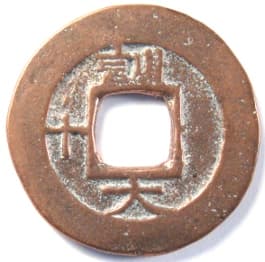
"tae"
"Big"
1857

"kong"
"Work"
1857
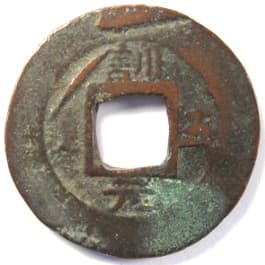
"won"
"The First"
1832
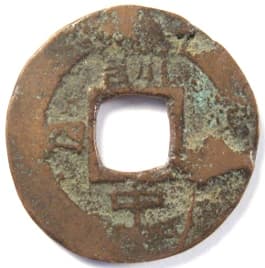
"chung"
"Middle"
1857
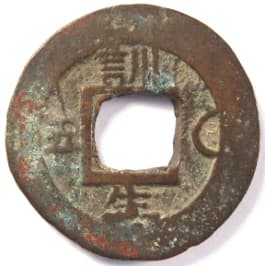
"saeng"
"Produce"
1832

"kwang"
"Light"
1852
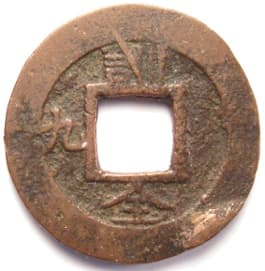
"chŏn"
"Perfect"
1832
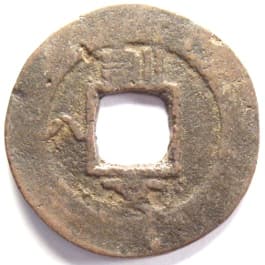
"mun"
"Cash"
1857
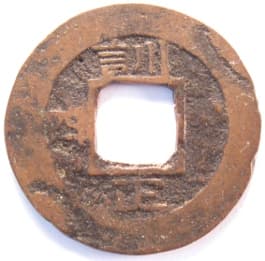
"chŏng"
"Upright"
1857
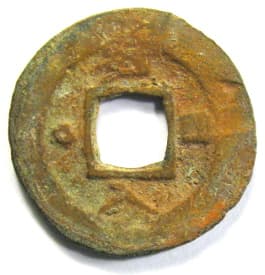
"ip"
"To Enter"
1806-1814
Korea's First Modern Milled Coinage
In 1892, after more than 250 years, casting of the sang pyong tong bo coins in copper and bronze finally ended.
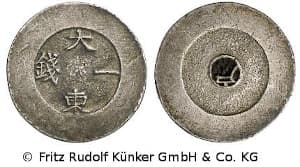 But prior
to that time, in the year 1882 which was the 19th
year of the reign of King Gojong (Kojong 高宗 고종), Korea began to
cast a new type of coin.
But prior
to that time, in the year 1882 which was the 19th
year of the reign of King Gojong (Kojong 高宗 고종), Korea began to
cast a new type of coin.Unlike the copper sang pyong tong bo coins, these coins were made of silver and no longer had a square hole in the center.
The inscription on these new coins begins with dae dong (大 東) and includes a number from one through three.
Dae dong (大 東) means "Great East" (Great Eastern Kingdom) and is another name for Korea.
The denomination was chon (錢) which was "1/10 of an ounce". A Korean "ounce" was 37.5 grams. The numbers "one" (一), "two" (二) and "three" (三) represented 0.1 ounce, 0.2 ounce and 0.3 ounce, respectively.
For example, the coin shown here is a number "one" (1 Chon 一錢, 20 mm, 3.4-3.7 grams) and the inscription is 大東一錢. The inscription for the 2 Chon coin (28 mm, 7.1-7.7 grams) is 大東二錢 and that for the 3 Chon coin (33 mm, 10.6 grams) is 大東三錢.
There are several varieties of the 3 Chon coin including large character, medium character and small character.
These new silver coins also have a distinctive reverse side. All the coins were made by the same Treasury Department Mint (戶曹 Hojo) that had been casting the sang pyong tong bo coins. However, the mint mark (戶 Ho) on the new coins was placed in a circle in the middle of the reverse side and was surrounded by colored enamel (blue, green or black).
Unfortunately, these new coins, which imitated Western coins, failed to achieve their goal of stabilizing the monetary system. The price of silver was rising as was the cost of production. The coins were hoarded by the yangban (양반 兩 班), who were the nobles and ruling class, and taken out of the country for their intrinsic metal content. As a result, minting of these coins ceased in June 1883.
In 1883, Korea purchased from Germany the equipment to produce milled (machine-struck) coins.
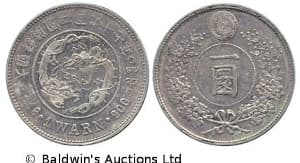 In 1888 (開國497), a
very small number of milled (machine-struck) coins
denominated in mun
(文) and hwan ("warn", "whan"
圜) were minted.
The "warn" was
equivalent to 1,000 mun.
In 1888 (開國497), a
very small number of milled (machine-struck) coins
denominated in mun
(文) and hwan ("warn", "whan"
圜) were minted.
The "warn" was
equivalent to 1,000 mun.The design of the coins was very similar to that of Japanese yen coins.
These coins were produced by the government mint in Seoul (gyeongseong 京成典圜局) in three denominations: 5 mun (5 文), 10 mun (10文) and 1 warn (1圜).
The 5 mun and 10 mun coins are composed of 98% copper, 1% tin and 1% zinc. The 5 mun coin has a diameter of 21.7 mm and a weight of 2.8 grams. The 10 mun coin has a diameter is 27.5 mm and a weight of 6.5 grams.
The 1 warn coin, which is displayed here, is particularly rare since only 1,300 coins were struck. It is composed of 90% silver and 10% copper. The diameter is 38 mm and the weight is 26.95 grams.
Korean Fun,
Yang and Whan Coins
(1892-1902)
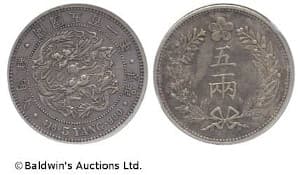 The currency of Korea
began to be based on the yang (兩) beginning in the year 1892 with
the implementation of the silver standard currency
reform. The yang
was further divided into fun (分) which was equal to 1/100th
of a yang.
The coin denominations and their compositions were 1 fun (brass),
5 fun (copper),
¼ yang (initially
cupronickel and later copper around silver), 1
yang (80% silver)
and 5 yang (90%
silver).
The currency of Korea
began to be based on the yang (兩) beginning in the year 1892 with
the implementation of the silver standard currency
reform. The yang
was further divided into fun (分) which was equal to 1/100th
of a yang.
The coin denominations and their compositions were 1 fun (brass),
5 fun (copper),
¼ yang (initially
cupronickel and later copper around silver), 1
yang (80% silver)
and 5 yang (90%
silver).An example of a 5 yang (五兩) coin minted in 1892 (開國501) is displayed at the left. Only 19,923 of these coins were produced.
There was also a 1 whan (1圜) coin minted in 1893 (開 國502) composed of 90% silver but this coin is extremely rare since only 77 coins were produced.
Some denominations in this series continued to be minted until 1902. All the coins were produced at the mint in Incheon (仁川典局).
The dates on the coins discussed above reflected the number of years since the founding (gaeguk 開國) of the Choson (Joseon) or Yi Dynasty in 1392 ("year 1") by General Yi Seong-gye. The Choson Dynasty (including the short-lived Korean Empire (1897-1910)) ended in 1910 when Korea became a colony of Japan.
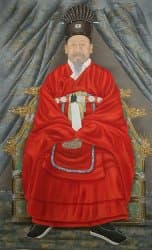 As a result of
the Sino-Japanese War (1894-1895), Korea found itself free
of Chinese hegemony. In 1897, the Yi (Choson,
Josean) Dynasty ended with King Gojong proclaiming the
establishment of the "Empire of Korea". In so doing,
King Gojong became Emperor Gwangmu.
As a result of
the Sino-Japanese War (1894-1895), Korea found itself free
of Chinese hegemony. In 1897, the Yi (Choson,
Josean) Dynasty ended with King Gojong proclaiming the
establishment of the "Empire of Korea". In so doing,
King Gojong became Emperor Gwangmu.A portrait of King Gojong, who became Korea's first emperor, is shown at the left.
Beginning in 1897, the regnal year of the monarch began to be used on coins to denote the year instead of calculating the year since the founding of the Choson Dynasty.
Coins minted 1897-1907 are dated from the year Emperor Gwangmu (Kuang Mu, Kwangmu 光武 광무제), formerly King Gojong (Kojong 高宗 고종) of the Choson (Yi) Dynasty, ascended the throne of the "Great Korean Empire" (大 韓帝國 대한제국 1897-1910) with the year 1897 being "year 1" (元年).
Coins minted 1907-1910 are dated from the year Emperor Yunghui (Yung Hi 隆熙 융희제), formerly known as Sunjong (純宗 순종), ascended the throne with 1907 being year 1" (元年).
The name of the country was variously displayed on the coins as "Great Korea" (大朝鮮), "Korea" (朝鮮) or "Daehan" (大韓).
Coins denominated in fun and yang continued to be minted from 1892-1902.
Examples of 1 fun, 5 fun and ¼ yang coins are shown below.
1 Fun (一分) Coins
The coins are composed of brass (95% copper and 5% aluminum).
In 1895, some coins were produced with the country name "Great Korea" (大朝鮮) while others were minted using the name "Korea" (朝鮮).
These coins have a diameter of 23.4 mm and a weight of 3.3 grams.
All 1 fun coins were made at the mint in Incheon (仁川典局).
Examples of 1 fun coins may be seen below.
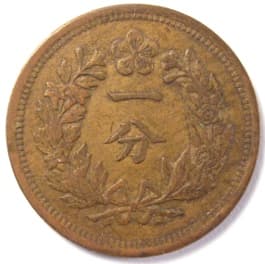
一分
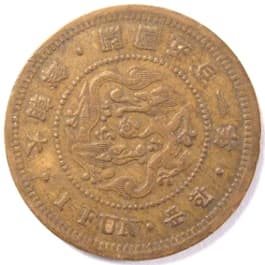
1892
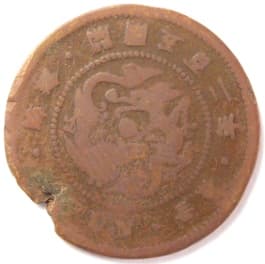
1893
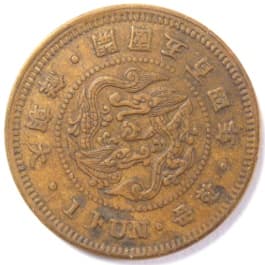
(大朝鮮)
1895
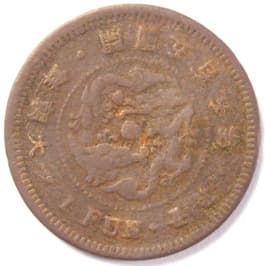
1896
5 Fun (五分) Coins
These copper coins are composed of 98% copper, 1% tin and 1% zinc.
The coin has a diameter of 27 mm, a thickness of 1.5 mm and a weight of 6.9 grams.
All 5 fun coins were made in Incheon (仁川典局) except for those produced in 1902 which were minted at Yongsan (龍山典局).
There are varieties with small (小子), medium (中子) and large (大字) characters or letters as well as ones displaying the country name as "Great Korea" (大朝鮮) , "Korea" (朝鮮) and "Daehan" (大韓).
These is an interesting story associated with these 5 fun coins involving Japanese samurai.
Japanese "Ronins" ("wave men" 浪人), who were samurai without masters, used Korean "5 fun" coins as the copper blanks or planchets to counterfeit Chinese "10 cash" (十文铜元) coins which then circulated in China's eastern provinces. For a detailed discussion of these counterfeit coins (han gai ban 韩改版) please see Chinese "10 Cash" Coins Overstruck on Korean "5 Fun" Coins.
Examples of Korean 5 fun coins may be seen below.

五分
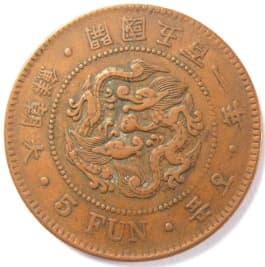
1892
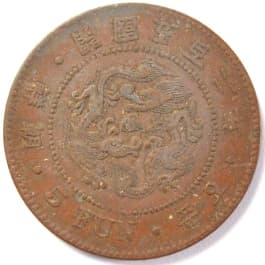
1893
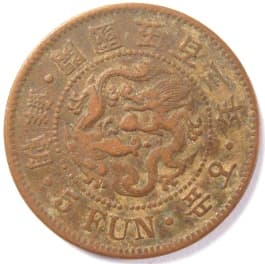
1894
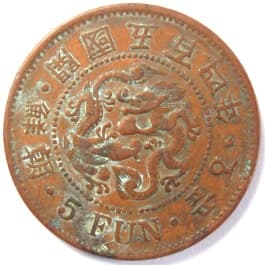
(朝鮮)
1895

(大朝鮮)
1895
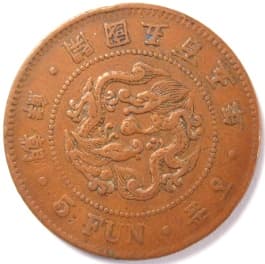
(朝鮮)
1896
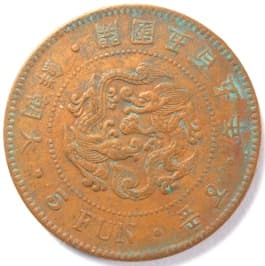
(大朝鮮)小字
1896
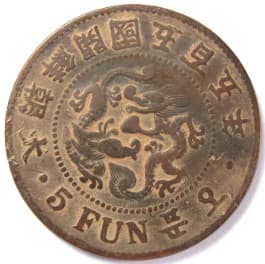
(大朝鮮)大字
1896
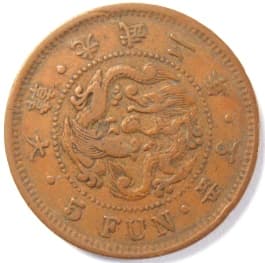
1898
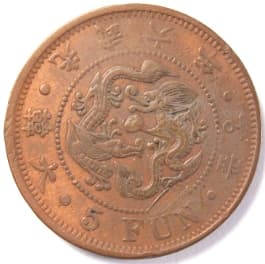
1902
¼ Yang (二錢五分) Coins
Their composition is 75% copper and 25% nickel.
These coins have a diameter of 20.7 mm and a weight of 4.8 grams.
Varieties of this coin were produced in certain years and can include differences in the country name ("Great Korea" 大朝鮮, "Korea" 朝鮮, "Daehan" 大韓) and the size of the letters or characters (large characters 大字, small characters 小字).
From 1892-1897, the ¼ yang coins were struck at the mint in Incheon (仁川典局). The Yongsan mint (龍山典局) produced these coins from 1998-1901.
Examples of ¼ yang coins are shown below.
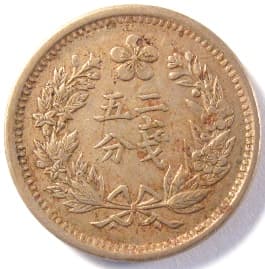
二錢五分
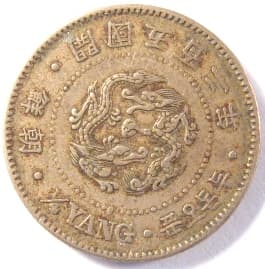
1893
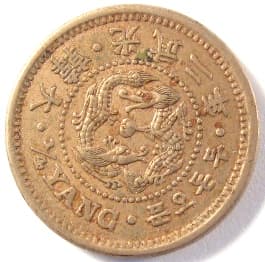
1898
Korean Gold Standard Coins (1906-1909)
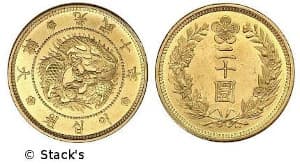 Gold coins were
minted in the three denominations of 5 won
(五園), 10 won (十園) and 20 won (二十園).
The won (園)
was equivalent to 20 chon
(錢).
Gold coins were
minted in the three denominations of 5 won
(五園), 10 won (十園) and 20 won (二十園).
The won (園)
was equivalent to 20 chon
(錢).An example of a 20 won gold coin dated 1906 (光武10年) is shown at the left.
All of the coins are composed of 90% gold and 10% copper.
The 5 won (五 園) coin has a diameter of 17 mm and a weight of 4.2 grams. The 10 won (十園) coin has a diameter of 21.2 mm and a weight of 8.3 grams. The 20 won (二 十园) coin has a diameter of 28.8 mm and a weight of 16.7 grams.
A distinctive feature of these coins is that there is no English inscription. The coins only have Chinese and Hangul (한 글) inscriptions.
The 5 won gold coins are dated 1908 (隆熙2年) and 1909 (隆 熙3 年). Only two pieces of the 1909 coin are known to exist with one piece selling at auction for $460,000 in September 2011.
The 10 won gold coins are dated 1906 (光武10年) and 1909 (隆熙3年). Only two examples of the 1909 coin are known to exist with one specimen selling at auction for $299,000 in September 2011.
The 20 won gold coins are dated 1906 (光武10年), 1908 (隆 熙2年) and 1909 (隆熙3年). Only two specimens of the 1909 coin are known to exist with one piece selling at auction for $632,500 in September 2011.
Because the Korean Mint Bureau, which had been striking coins for 20 years, was pressured to close by the Japanese in 1904, all of these gold coins were produced at the mint in Osaka, Japan (日本大阪造幣局).
Korean Chon
and Won
Coins (1902-1910)
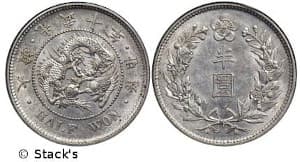 The coin
denominations consisted of ½ chon (半
錢), 1
chon (一
錢), 5 chon (五
錢), 10 chon (十
錢), 20 chon
(二十錢), and half won
(半
園).
The coin
denominations consisted of ½ chon (半
錢), 1
chon (一
錢), 5 chon (五
錢), 10 chon (十
錢), 20 chon
(二十錢), and half won
(半
園).The half won (半園) coins were only minted during the years 1905-1908.
At the left is an example of a half won (半園) coin struck during the 10th year (1906) of the reign of Emperor Gwangmu.
The half won coins made in 1905 and 1906 are composed of 80% silver and 20% copper. The diameter is 31 mm and the weight is 13.5 grams.
The half won coins struck in 1907 and 1908 are also 80% silver and 20% copper but are slightly smaller with a diameter of 27.5 mm and a weight of 10.0 grams.
The dragon symbol was replaced by the phoenix on the ½ chon, 1 chon and 5 chon coins.
All of the coins from this period were made at the mint in Osaka, Japan (日本大阪造幣局).
Examples of these coins are shown below.
½ Chon (半
錢) Coins
For the first year (1906 "gwangmu 10"), the ½ chon coin had a diameter of 21.9 mm, thickness of 1.5 mm, and weight of 3.4 grams.
The coin was slightly smaller in all of the following years with a diameter of 19.1 mm, thickness of 1 mm, and weight of 2.1 grams.
The composition of all the ½ chon coins are the same: 95% copper, 4% tin and 1% zinc
There is some question as to whether or not a ½ chon coin was minted in the 11th year of the reign of Gwangmu (Kuang Mu).
Also, the ½ chon coins minted in 1907 (yunghui, yung hi first year) and 1910 (yunghui, yung hi year 4) are very scarce.
Examples of Korean ½ chon coins are shown below.
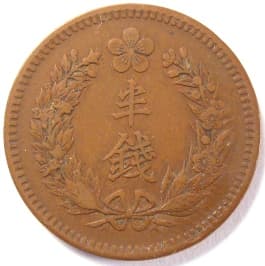
半錢
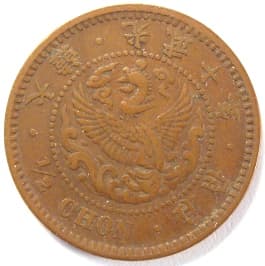
1906
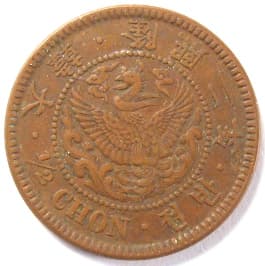
1908
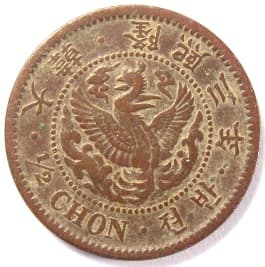
1909
1 Chon (一錢) Coins
For the first two years (1905-1906), the coins had a diameter of 28 mm, a thickness of 1.5 mm, and a weight of 7.1 grams.
The coins produced during the following years (1907-1910) were smaller with a diameter of 22.5 mm, a thickness of 1 mm, and a weight of 4.1 grams.
All the 1 chon coins, however, had the same composition: 98% copper, 1% tin, and 1% zinc
Shown below is a complete set of Korean 1 chon coins.
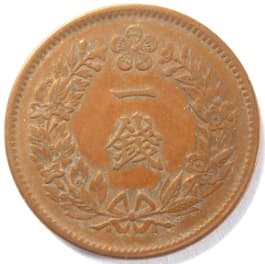
一錢
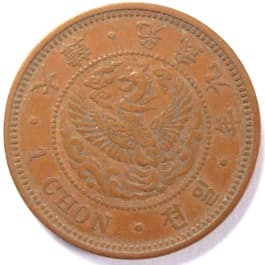
1905
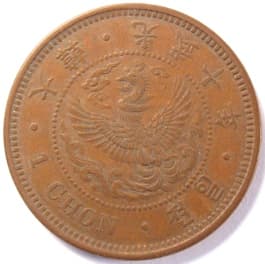
1906
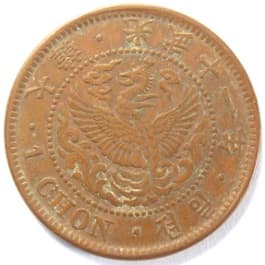
1907
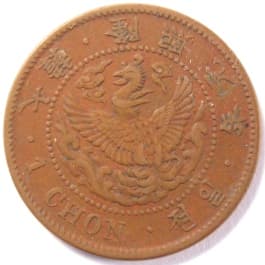
1907
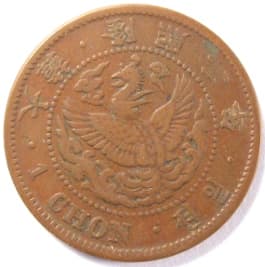
1908
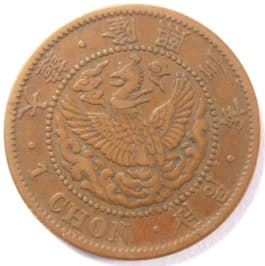
1909
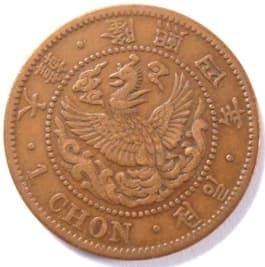
1910
5 Chon (五錢) Coins
One 1909 5 chon coin sold at auction for $138,000 in September 2011.
All the coins were made at the mint in Osaka, Japan (日本大阪造幣局) and have a diameter of 20.8 mm, a thickness of 2 mm, and a weight of 4 grams.
The composition of the coins are 75% copper and 25% nickel.
Examples of the 5 chon coins may be seen below.
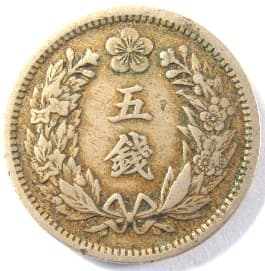
五錢
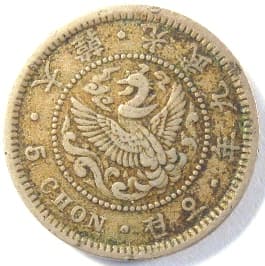
1905
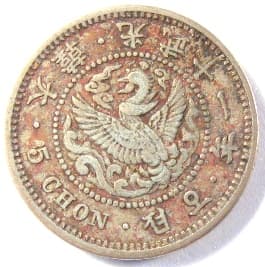
1907
10 Chon (十錢) Coins
All the 10 chon coins are silver with a composition of 80% silver and 20% copper.
The coins have a diameter of 17.6 mm and a thickness of 1.5 mm. All the coins weigh 2.5 grams with the exception of those dated 1907 (gwangmu 11) which weigh 2.25 grams.
Also, all the coins were produced at the mint in Osaka, Japan (日本大 阪造幣局).
Examples of the 10 chon coins are shown below.
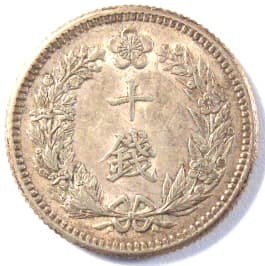
十錢
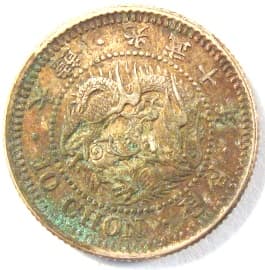
1906
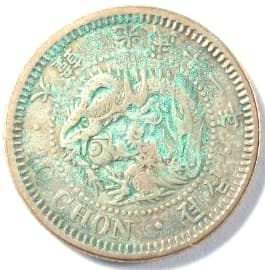
1907

1908
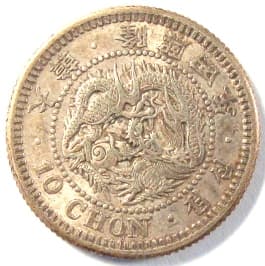
1910
20 Chon (二十錢) Coins
During the years 1905 (gwangmu 9) and 1906 (gwangmu 10), the 20 chon coins had a diameter of 22.8 mm, a thickness of 1.5 mm and a weight of 5.4 grams.
The coin was slightly smaller in the following years with a diameter of 20.3 mm, a thickness of 1.5 mm and a weight of 4 grams.
The composition of all the coins, however, was the same: 80% silver and 20% copper
Examples of 20 chon coins are shown below.
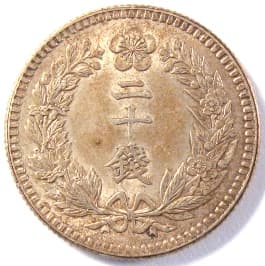
二十錢
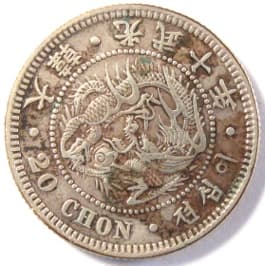
1906
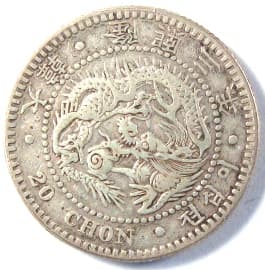
1909
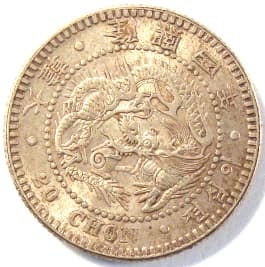
1910
Korean "Eagle" Coins Issued by the Russo-Korean Bank
As a result of the First Sino-Japanese War (1894-1895), China's influence in Korea was replaced by that of the victorious Japanese. China's weakened position also allowed for Russian interests in the Far East to expand greatly.
Under the leadership of Mr. Alexiev, who was the financial advisor to Korea sent by Russia, the first Asian branch of the Russo-Korean Bank was established on March 1, 1898.
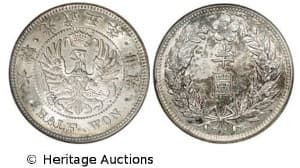 In 1901, Alexiev
authorized the minting of a new set of three coins.
The denominations were 1 chon (一錢 28 mm, 8 grams),
5 chon (五
錢 20.5 mm, 5.4 grams) and half won
(半園
30.9 mm, 13.5 grams).
In 1901, Alexiev
authorized the minting of a new set of three coins.
The denominations were 1 chon (一錢 28 mm, 8 grams),
5 chon (五
錢 20.5 mm, 5.4 grams) and half won
(半園
30.9 mm, 13.5 grams).An example of the half won coin is shown at the left.
The half won coins are dated 1901 (Gwangmu year 5 光武5年) while the 1 chon and 5 chon coins are dated 1902 (Gwangmu year 6 光武6年).
The composition of the half won coin is 90% silver and 10% copper.
The composition of the 1 chon coin is 98% copper, 1% tin and 1% zinc while that of the 5 chon coin is 75% copper and 25% nickel.
A major characteristic of these coins is that the image of the Crowned Russian Imperial Eagle replaced the traditional dragon or phoenix. For this reason, these coins are referred to as "eagle" coins or the Eagle Series.
There was also a set of experimental or trial coins produced but never circulated. This coin series included a copper 10 won, copper 20 won and silver "half dollar" (half won). All these trial coins were reportedly minted in 1901 although the coins display dates of 1899, 1901, 1902 or 1903.
All of the "eagle" coins were produced at the mint at Yongsan, Korea (龍 山典局).
Japan was the victor in the Russo-Japanese War (1904-1905) and, as a consequence, confiscated and destroyed almost all of the "eagle" coins. For this reason, these coins are very rare.
One example of a 1 chon coin dated 1902 sold at auction for $149,500 in September 2011. A 20 won coin dated 1902 sold at the same auction for $115,000.
Korea became a Japanese protectorate under the Eulsa Treaty of 1905 and was annexed by Japan in 1910.
The "Japanese Imperial Period" in Korea ended in 1945 with Japan's defeat in World War II.
Modern Korean Coins
The new coins were denominated as won (원). The first of Korea's modern coinage was a series of coins with denominations of 10 won, 50 won and 100 won.
These first coins were issued in 1959 and minted at the Philadelphia Mint in the United States.
The 10 won coin has an image of the mugunghwa (Rose of Sharon 무궁화) flower which is the national flower of Korea. The coin's composition is 95% copper and 5% zinc. The coin has a diameter of 19.1 mm and a weight of 2.46 grams.
The 50 won coin shows an image of the famous "Turtle Ship" (kobukson 거북선 龜船) designed by Admiral Yi Sunsin (李舜臣). This warship had a curved ironclad deck which was covered with iron spikes. These ships proved successful in battles against the Japanese who tried to conquer Korea during the years 1592-1598.
The 50 won coin has a composition of 70% copper, 18% zinc and 12% nickel. The coin has a diameter of 22.86 mm and a weight of 3.69 grams.
The final coin in this series is the 100 won coin. The coin displays the portrait of Syngman Rhee (이 승만 李承晩) who was the first president of the Republic of Korea. The coin has a composition of 75% copper and 25% nickel. The diameter is 26 mm and the weight is 6.74 grams.
All three coins in the series were minted in 1959 but the date on the coins is "4292".
Up until the year 1961, Korea used the traditional Korean calendar which calculates the year from the time when the first Korean kingdom was established. According to ancient Chinese and Korean texts, Dangun Wanggeom (단군왕검 檀 君王檢) established the kingdom of Gojoseon (고 조선 古朝鮮) in the year 2333 BC. The year "4292" in the Korean calendar is therefore equivalent to the year "1959" in the Gregorian or Western calendar.
The 10 won and 50 won coins, but not the 100 won coin, were again minted in the year "4294" (1961). Korean coins after 1961 show the year according to the Western calendar.
The 100 won coin was withdrawn from circulation in 1962 but the 10 won and 50 won coins circulated until 1975.
This complete series of coins is shown below.
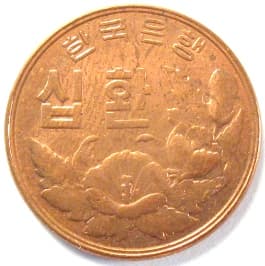
10 won
Mugunghwa Flower
(Rose of Sharon)
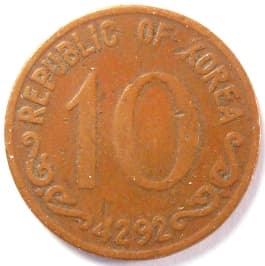
(Korean calendar year 4292)
1959
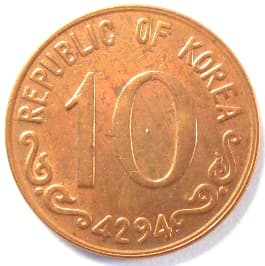
(Korean calendar year 4294)
1961

50 won
Turtle Ship
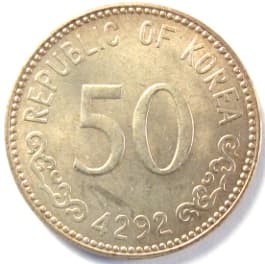
(Korean calendar year 4292)
1959
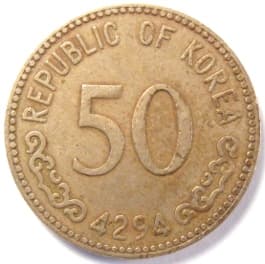
(Korean calendar year 4294)
1961
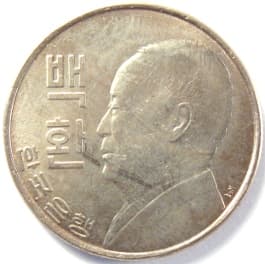
100 won
Syngman Rhee
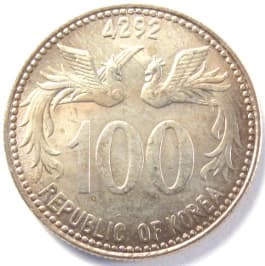
(Korean calendar year 4292)
1959
Return to Ancient Chinese Charms and Coins

